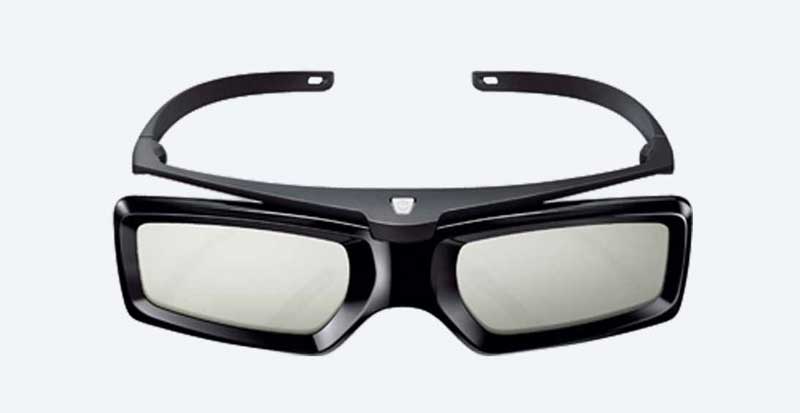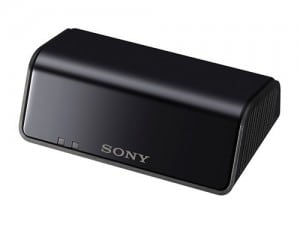3D Glasses Are Optional
Although Sony includes 3D glasses with some projectors a while back, they no longer do. That's OK, though, considering how much the price of those glasses has dropped, in a few years

Sony's TDG-BT500A RF 3D glasses for the VPL-HW45 and HW65ES and other new Sony home theater projectors
Sony's current 3D glasses, RF TDG-BT500A is the model number - are optional (and lighter, and more comfortable than their older IR glasses). While projector manufacturers set their glasses prices pretty high (expect to pay around $50 for the Sony's), there are some very low cost ones. There are inexpensive Samsung glasses that I use with the Epson and Sony projectors that are very lightweight, and cost less than $20 a pair. They do use button Lithium batteries, rather than being rechargeable, so there's extra expense as a trade-off against remembering to recharge, but still: You can probably watch up to 100 hours of 3D content on a less than $2 battery, so I don't see that as a problem! That works out to less than $0.04 per 3D movie! So if you want a whole bunch of 3D glasses for those movie nights, know that there are affordable options, like the Samsungs I use. Epson's glasses flick when used with the Sony. I did not notice a problem with the Samsung on the Sony, but the forums have reported occasional flickering.
SONY Wireless HDMI Option
The concept of wireless HDMI is a great one. If you are installing a projector, such as ceiling mounting, you do have to get your power to the projector. But you also have to get your sources there. Today, HDMI is the standard. The issue is that whether your projector, if permanently placed, is ceiling mounted, or on a high rear shelf, you also have to get your sources hooked up. Unfortunately they are usually not near by. Most folks will want to run the wires through the wall, and that means a lot of installation and cable running. By comparison, getting power to the projector is simple and closer. Thus, having a wireless HDMI solution can mean not opening up a couple of walls to run wire, not spending many hundreds of dollars to installers for doing that.

Sony's optional wireless HDMI module. The receiver side plugs right into one of the HDMI inputs, just as a 3rd party solution would.
We did not have the opportunity to test the Sony IFU-WH1 wireless HDMI rig with its multiple HDMI inputs, but we have reviewed several stand alone ones, and also one similar solution from another projector company - in that case Epson. In all cases, the signal has appeared clean under normal use (reasonable distances).
But there are limitations. For those of you used to the time it takes to get your projector or TV to start up a Blu-ray disk, for example, the source keeps changing resolutions and settings. Add to that HDCP - the copy protection scheme, which really slows such things down. Without wireless, we are used to flashes, or messages, repeatedly, and it may often take 4 to 10+ seconds to get the real content on the screen, where that HDCP is in use. At least we see the flashes, the messages, etc., when hard wired, so we know things are trying to work. With wireless HDMI, you don't see a lot of those intermediate changing signals from the player. It's the inconvenience of waiting, without the usual things happening that tell you that it's working. In other words after 5 or 7 seconds with a blank screen, I start wondering. My experience is that the wireless will work, and it won't actually take longer, t's just that you won't know exactly what's going on, until the picture finally appears. Like most wireless HDMI offerings, the Sony's is lossless, the picture quality should be identical to using a good quality, expensive cable.
So, the Wireless HDMI is a great additional feature for the Sony VPL-HW45ES. Most folks probably don't need it, but if wireless HDMI beats opening up more walls, and more installer expense, it's a great thing to have. And since it's optional, you aren't really paying for it if you don't need it. Of course there are several 3rd party wireless HDMI solutions, we've reviewed some of those (DVDO, Peerless...)
Sony Motion Enhancer - Creative Frame Interpolation
Motion Enhancer control is found on the Motionflow sub-menu off of the main Picture menu. It is one of two features there, the other being Film Projection, which is the 3:2 pull-down feature (when On), and does 24 fps, when off.
Selecting Motion Enhancer gives you three choices, Off, Low, and High. This is your creative frame interpolation (CFI) otherwise referred to as "smooth motion".
Overall, CFI which I don't use with movies, is very smooth, artifacts around moving objects are relatively very hard to spot, even in the high setting it's pretty good.
The Sony projector has 240 frame per second capabilities, that allows a lot of creativity when working with 30 or 60 fps source material. Black frames can be inserted or new frames that fall between original ones that interpolate the motion.



